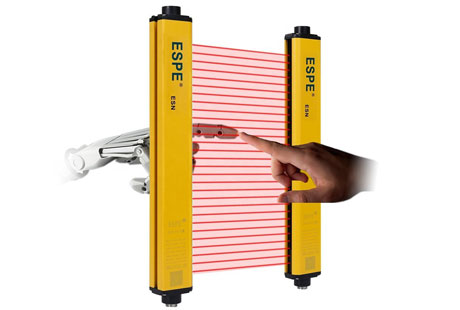What Is Safety Light Curtain Sensor?
Key Takeaway
A safety light curtain sensor is a protective device used mainly in industrial environments to prevent accidents. It works by forming an invisible barrier using beams of light. If something, like a person’s hand or any object, breaks these beams, the sensor immediately triggers the machinery to halt. This quick action stops the machine from continuing operations that could lead to injuries.
The system is crucial in areas where safety is paramount, ensuring that operations are stopped as soon as a risk is detected, and making workplaces safer for everyone involved.

Defining Safety Light Curtain Sensors
Safety light curtains are advanced barrier sensors used mainly to prevent access to areas where machinery operates at high risk. Essentially, they consist of multiple beams of infrared light stretched across an area; the interruption of any beam by an object—like a person’s hand or the entire body—triggers a safety mechanism that stops the machine immediately. This preventive technology is crucial for areas such as mechanical presses, and assembly lines, where mechanical movements can pose significant risks to human safety.

Basic Operation and Functionality
The fundamental operation of a safety light curtain revolves around its ability to detect interruptions in its light grid. The system comprises two main parts: a transmitter and a receiver. The transmitter emits a series of parallel infrared light beams directed towards the receiver. When these beams are unbroken, the machine operates as usual. However, when an object obstructs any of the beams, the receiver detects this interruption and signals the machinery’s control system to initiate a stop command. This action occurs within milliseconds, effectively preventing potential accidents and injuries.
Components of a Light Curtain System
A typical light curtain system includes:
Transmitters: These are devices that emit infrared beams. They are usually aligned vertically in a bar or a column along one side of the machinery.
Receivers: Positioned directly opposite the transmitters, these components detect the beams. Any disruption in the light pattern is immediately processed to trigger the machinery to halt.
Control Interface: This component integrates the light curtain with the machine’s operational controls. It processes the information sent from the receivers and implements the emergency stop operation.
Mounting Equipment: Robust housing and brackets that keep the transmitters and receivers aligned and secure against operational vibrations or external impacts.
Cabling and Connectors: Essential for power and data transmission between the system components and the central control system of the machinery. Cabling must be robust to withstand industrial environments and ensure consistent operation.
Interface Modules: These allow the light curtain system to communicate with the wider safety system or machine control. They convert the signals from the light curtain into a format that can be understood by the machine’s main controller, facilitating integration and response coordination.
Core Technology Behind Light Curtains
The effectiveness of safety light curtains is underpinned by the reliability of their detection and response systems. Modern curtains use modulated infrared light to minimize false triggers caused by ambient lighting or reflections. Furthermore, most systems are equipped with self-checking circuitry that continuously monitors their operational integrity. This feature ensures that any failure within the system itself, such as a burnt-out emitter or a fault in the receiver, is detected promptly, thus maintaining the reliability of the safety mechanism.
Choosing the Right Safety Light Curtain
Selecting an appropriate safety light curtain involves considering several factors:
Resolution: This refers to the density of the infrared beams. Higher resolution curtains detect smaller objects, crucial in environments where even minor intrusions must trigger machine stops.
Height and Coverage: The size of the curtain should match the area that needs protection. It’s essential to cover the entire hazardous zone where human access needs control.
Response Time: It is vital to choose a curtain with a response time quick enough to stop the machinery before contact can be made with moving parts.
Safety Ratings and Compliance: Ensure the curtain meets relevant safety standards and complies with local regulations, which can vary widely depending on the industry and type of machinery.
Conclusion
Safety light curtains are a vital component in the arms of industrial safety measures, blending high-end technology with critical functionality to protect workers. Understanding how these devices operate, their integral components, and the criteria for selecting the right system not only enhances safety protocols but also supports compliance with stringent industrial safety standards. For engineers, safety managers, and all stakeholders in industrial operations, investing time to understand and implement effective safety light curtain solutions is indispensable, ensuring that safety and efficiency exit together harmoniously in high-risk environments.
